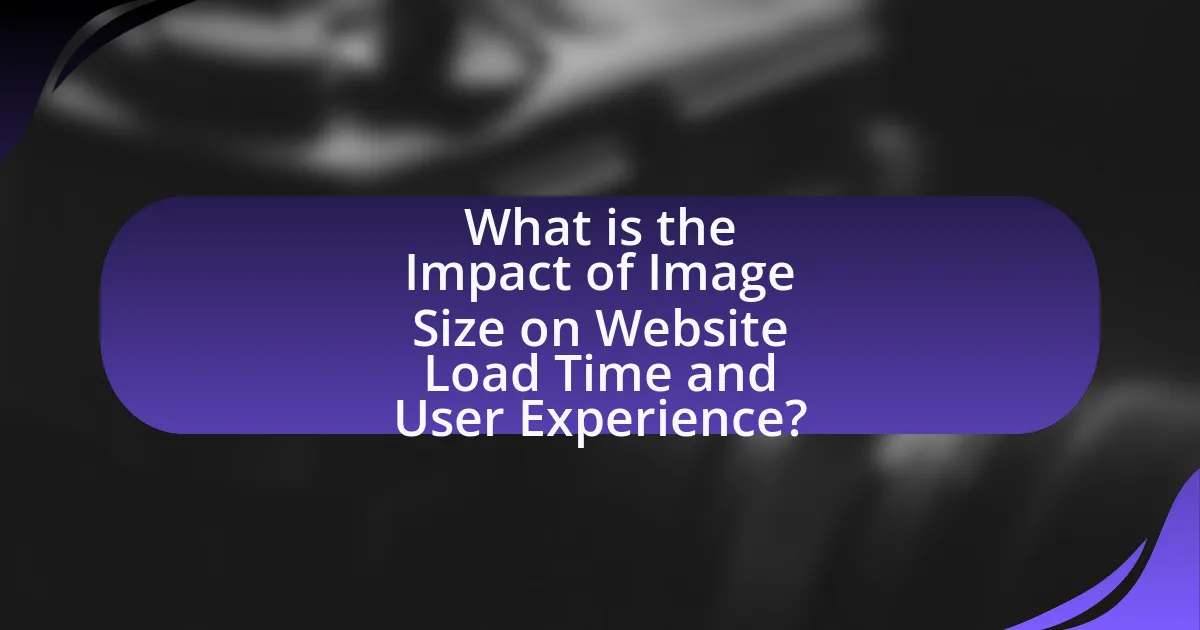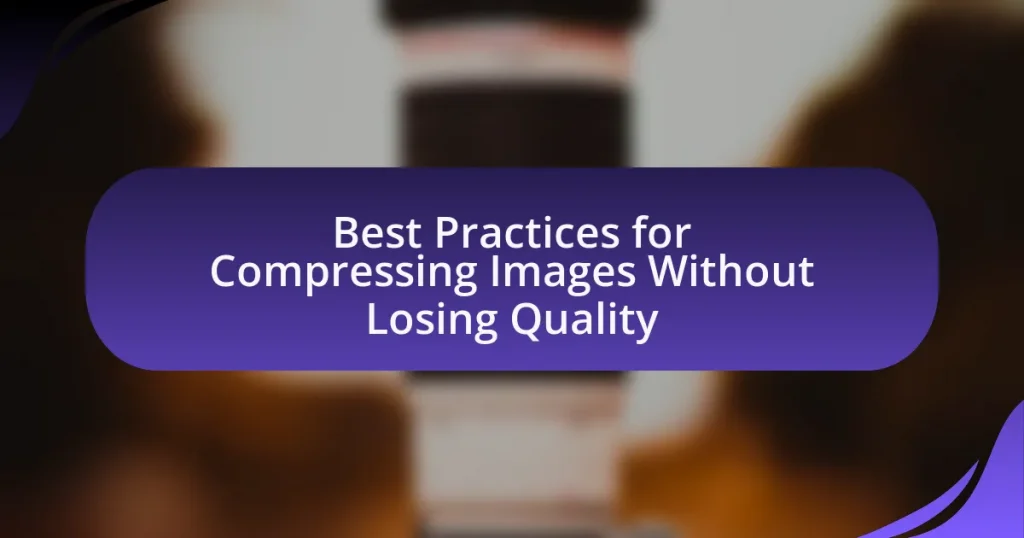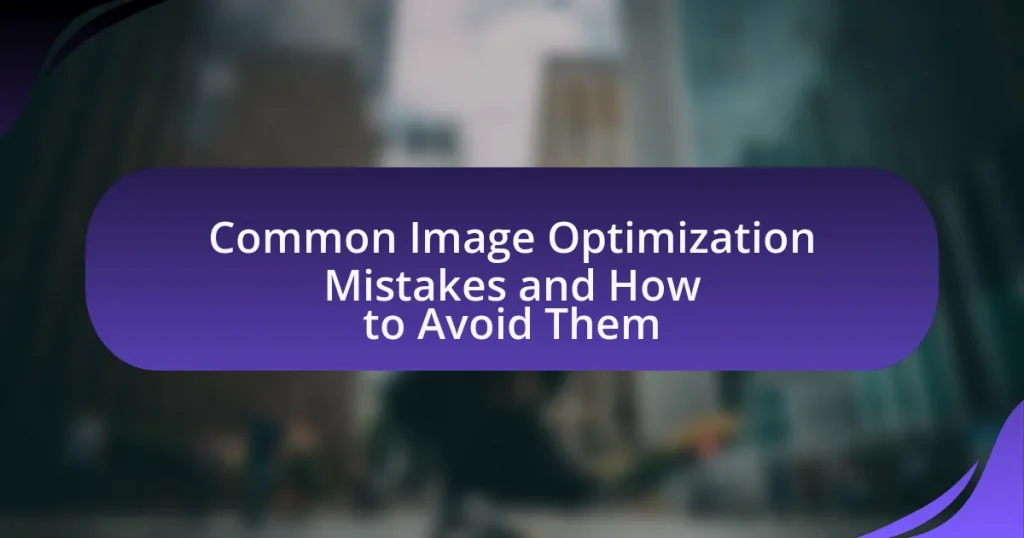The article examines the significant impact of image size on website load time and user experience. It highlights how larger images can lead to slower loading speeds, increased bounce rates, and reduced conversion rates, emphasizing that a mere one-second delay can decrease conversions by 7%. The discussion includes technical aspects of image size, the influence of different image formats, and the importance of image optimization techniques such as compression and responsive design. Additionally, it outlines best practices for managing image sizes to enhance website performance and user satisfaction, while also addressing common pitfalls to avoid in image handling.
What is the Impact of Image Size on Website Load Time and User Experience?

Image size significantly affects website load time and user experience. Larger images increase load times, leading to higher bounce rates; studies show that a 1-second delay in load time can reduce conversions by 7%. Additionally, Google reports that mobile users expect a page to load in under 3 seconds, and images that are not optimized can hinder this expectation, resulting in a poor user experience. Therefore, optimizing image size is crucial for maintaining fast load times and enhancing user satisfaction.
How does image size influence website load time?
Image size significantly influences website load time, as larger images require more data to be transferred, resulting in slower loading speeds. When images are not optimized, they can increase the overall page size, leading to longer download times for users. Research indicates that a one-second delay in page load time can lead to a 7% reduction in conversions, highlighting the importance of image size in maintaining user engagement and satisfaction.
What are the technical aspects of image size affecting load time?
Image size significantly affects load time due to the amount of data that needs to be transferred over the internet. Larger images require more bandwidth and take longer to download, which can lead to increased loading times for web pages. For instance, a study by Google found that reducing image size by 100 KB can improve load time by approximately 0.5 seconds on a mobile network. Additionally, image dimensions and file formats also play a crucial role; for example, using formats like JPEG or WebP can reduce file size without compromising quality, further enhancing load speed.
How do different image formats impact load time?
Different image formats significantly impact load time due to their varying compression methods and file sizes. For instance, JPEG images typically have smaller file sizes compared to PNG images because JPEG uses lossy compression, which reduces quality to decrease size, making them load faster. Conversely, PNG images, which use lossless compression, retain quality but often result in larger file sizes, leading to slower load times. Additionally, newer formats like WebP offer superior compression, allowing for smaller file sizes while maintaining quality, thus improving load times compared to traditional formats. Studies show that optimizing image formats can reduce load times by up to 80%, enhancing user experience and engagement on websites.
Why is website load time critical for user experience?
Website load time is critical for user experience because it directly affects user satisfaction and engagement. Research indicates that a one-second delay in page load time can lead to a 7% reduction in conversions, as users are likely to abandon slow-loading sites. Additionally, Google reports that 53% of mobile users will leave a page that takes longer than three seconds to load. Fast load times enhance user retention and improve overall site usability, making it essential for maintaining a positive user experience.
What are the consequences of slow load times on user engagement?
Slow load times significantly decrease user engagement. Research indicates that a one-second delay in page load time can lead to a 7% reduction in conversions, as users are more likely to abandon a site that takes too long to load. Additionally, 40% of users abandon a website that takes more than three seconds to load, highlighting the critical nature of speed in retaining user interest. Consequently, slow load times can result in higher bounce rates, reduced time spent on the site, and ultimately lower customer satisfaction and loyalty.
How does load time affect conversion rates?
Load time significantly affects conversion rates, as slower loading websites lead to higher bounce rates and lower user engagement. Research indicates that a one-second delay in page load time can result in a 7% reduction in conversions, according to a study by Akamai. Additionally, Google found that 53% of mobile users abandon sites that take longer than three seconds to load. These statistics demonstrate that optimizing load time is crucial for improving conversion rates and enhancing overall user experience.
What role does image optimization play in improving load time?
Image optimization significantly reduces load time by decreasing the file size of images without compromising quality. When images are optimized, they consume less bandwidth and load faster, which enhances the overall user experience. Studies show that optimized images can reduce page load times by up to 80%, leading to lower bounce rates and higher engagement. For instance, Google reports that a one-second delay in loading time can result in a 20% decrease in conversions. Therefore, effective image optimization is crucial for improving website performance and user satisfaction.
What techniques can be used for image optimization?
Techniques for image optimization include compression, resizing, and format selection. Compression reduces file size without significantly affecting quality, with tools like JPEGmini and TinyPNG achieving up to 80% size reduction. Resizing images to the exact dimensions needed for display prevents unnecessary data from being loaded, improving load times. Format selection involves using appropriate file types; for example, JPEG is ideal for photographs, while PNG is better for images requiring transparency. Implementing these techniques can significantly enhance website load time and user experience, as studies show that a 1-second delay in load time can lead to a 7% reduction in conversions.
How does compression affect image quality and load time?
Compression reduces image file size, which directly improves load time. When images are compressed, they take up less bandwidth, allowing web pages to load faster, which is crucial for user experience and search engine optimization. However, excessive compression can lead to a noticeable decline in image quality, resulting in pixelation or loss of detail. Studies indicate that a balance must be struck; for instance, lossy compression can reduce file sizes by up to 90% with acceptable quality loss, while lossless compression maintains quality but achieves less size reduction. Therefore, effective compression techniques can enhance load times without significantly compromising image quality.
How can website owners assess the impact of image size on performance?
Website owners can assess the impact of image size on performance by utilizing web performance testing tools that measure load times and user experience metrics. Tools such as Google PageSpeed Insights, GTmetrix, and WebPageTest provide detailed reports on how image sizes affect overall page load speed, which is critical for user retention and SEO rankings. For instance, studies show that reducing image sizes can lead to a significant decrease in load times; a 1-second delay in page response can result in a 7% reduction in conversions. By analyzing these metrics, website owners can make informed decisions about optimizing image sizes to enhance performance.
What tools are available for measuring website load time and image size effects?
Tools available for measuring website load time and image size effects include Google PageSpeed Insights, GTmetrix, and WebPageTest. Google PageSpeed Insights analyzes the content of a web page and provides suggestions to make that page faster, including metrics on load time and image optimization. GTmetrix combines Google Lighthouse and WebPageTest to offer detailed reports on page performance, including load time and the impact of image sizes. WebPageTest allows users to run tests from different locations and browsers, providing comprehensive data on load times and resource sizes, including images. These tools are widely used in web development and optimization to enhance user experience by improving load times and managing image sizes effectively.
What best practices should be followed for managing image sizes on websites?
To manage image sizes on websites effectively, it is essential to optimize images for web use. This includes using appropriate file formats such as JPEG for photographs and PNG for images requiring transparency, as these formats balance quality and file size. Additionally, implementing responsive images through HTML attributes like “srcset” allows for different image sizes to be served based on the user’s device, enhancing load times and user experience.
Furthermore, compressing images using tools like TinyPNG or ImageOptim can significantly reduce file sizes without noticeable loss of quality, which is crucial since studies show that a 1-second delay in page load time can lead to a 7% reduction in conversions. Finally, utilizing lazy loading techniques ensures that images are only loaded when they enter the viewport, further improving initial load times and overall performance.
How can responsive images enhance user experience?
Responsive images enhance user experience by ensuring that images are displayed optimally across various devices and screen sizes. This optimization reduces loading times, as smaller images are served to mobile devices, which improves performance and decreases bounce rates. Studies show that websites with faster loading times can see a 70% increase in user engagement, as users are more likely to stay on a site that loads quickly. Additionally, responsive images maintain visual quality, providing a seamless experience that meets user expectations regardless of the device used.
What are the common pitfalls to avoid when handling image sizes?
Common pitfalls to avoid when handling image sizes include using excessively large images, neglecting to optimize images for web use, and failing to implement responsive design. Using excessively large images can significantly slow down website load times, negatively impacting user experience; studies show that a 1-second delay in load time can lead to a 7% reduction in conversions. Neglecting to optimize images, such as not compressing them or using the wrong file format, can also lead to unnecessarily large file sizes, which further affects loading speed. Lastly, failing to implement responsive design can result in images not displaying correctly on different devices, leading to poor user engagement and increased bounce rates.



